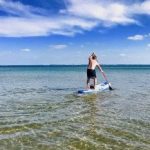SUP FAQ
What is a SUP Board?
A SUP Board (Stand Up Paddling Board) is basically an oversized surfboard on which you can stand in the water.
With a paddle you get ahead. Many boards are now inflatable. These weigh significantly less and can be easily transported in a backpack.
What does SUP stand for?
The abbreviation SUP stands for Stand Up Paddling or Stand Up Paddle. Some pronounce the letters one at a time while others pronounce SUP as a word.
What does iSUP stand for?
This abbreviation stands for inflatable Stand Up Paddling Board. This specifically refers to the inflatable boards
How Expensive is an Inflatable Stand Up Paddling Board?
Inflatable Stand Up Paddling Boards are already available for a few hundred euros at the discount store or online. The prices of other models are also over 1000 €.
Are inflatable boards good for anything?
Definitely! I find them very convenient in transport, they are usually a bit cheaper and once filled with air rock hard, so hardly a difference to hardboards is ausmachbar.
It is not for nothing that inflatable boards now account for more than 90% of the market.
How big should my SUP board be?
If you choose a Stand Up Paddling Board, the size of it depends on what you want to use it for.
Short boards under 275 cm in length are better for quick turns than longer boards. They are mainly used for a mix of SUP and surfing. Also for kids, the short boards are less than 275cm (9ft).
Medium-sized boards ranging from 275 cm to 365 cm are the most popular. They are the all-rounders. Boards in this area can handle silent lakes, rivers and smaller waves.
Long boards over 380 cm (12 ft 6 in) are typically used for touring or racing. With them, high speeds can be achieved, but there are losses in maneuverability and stability.
Which is the best board?
The answer is up to you. How much do you weigh? What is your budget? What are your plans for the board?
These are all important questions.
You are well advised to look at my SUP board reviews and then decide.
Do I have to wax my board?
In most cases, you do not have to. Almost every model is specially coated, so it gives good grip.
Look in product descriptions for the keyword EVA deck. Today, however, this is standard.
Do I need wind and waves for stand up paddling?
No, no way! Most Stand Up paddlers do not surf the waves but paddle on shallow water.
How do I stand correctly on the board?
You are standing correctly on the board when the back end of the board is not underwater and the tip does not protrude above the water.
Your feet should be parallel shoulder width apart and directed forward.
A good indicator of the right place to stand are the often-applied carrying handles, because they are located exactly at the center of gravity of the board.
How big should my paddle be for Stand Up Paddling?
The right paddle size can be easily determined. Place the paddle vertically in front of your feet. Put your handballs on the handle. Your arm should be stretched in the right paddle length, but still be able to lie relaxed on the paddle.
No paddle at hand? With the rule of thumb paddle length = body size + 20cm you have a good impression.
In my guide to SUP paddles I advise anyway to height-adjustable paddles. With those you can readjust later.
How much does a paddle board weigh?
In the old days, the boards weighed around 15 kilograms. Today the weight varies more. Some models only weigh 7 kilograms others up to 20 kilograms. Inflatable boards are usually lighter than hardboards.
How long does an inflatable SUP board last?
Of course, that depends on the quality of production. Modern models of good brands are almost indestructible.
What should I wear to stand up paddling?
In summer you can wear swim shorts or a bikini – also with cap and sunglasses. It is best to wear sunscreen with a high sun protection factor.
In autumn and winter it may be a bit more. Recommended is a wet or drysuit. When it is really cold, you should especially pay attention to hands ( neoprene gloves) and feet ( SUP socks , neoprene shoes, etc.).
What is a good place to stand up paddling?
For beginners, the waters should be as calm as possible and free of currents, many obstacles and waves.
Above all, lakes and canals are well suited for entry. After a few tries, you can venture to more difficult waters.
In my SUP cards ( Germany map , Austria map , Switzerland map many great spots for beginning to find).
Contents
Author

Hi, I’m Manfred. For years I’ve written here on standup-experte.com about SUP and everything that goes with it.